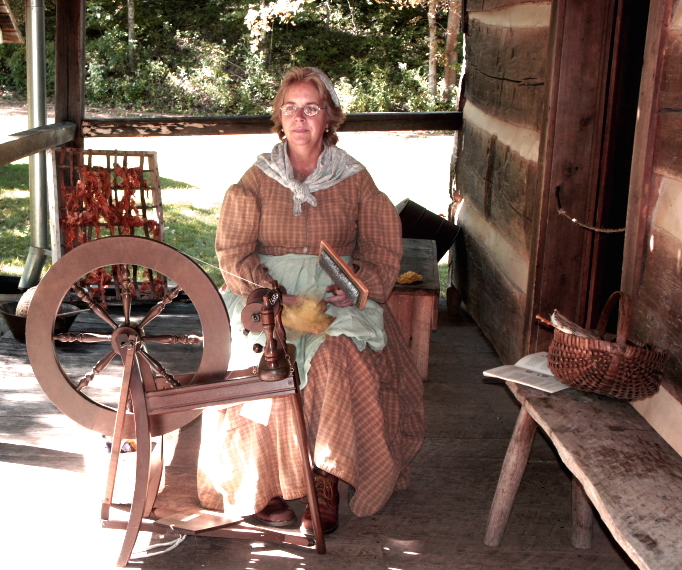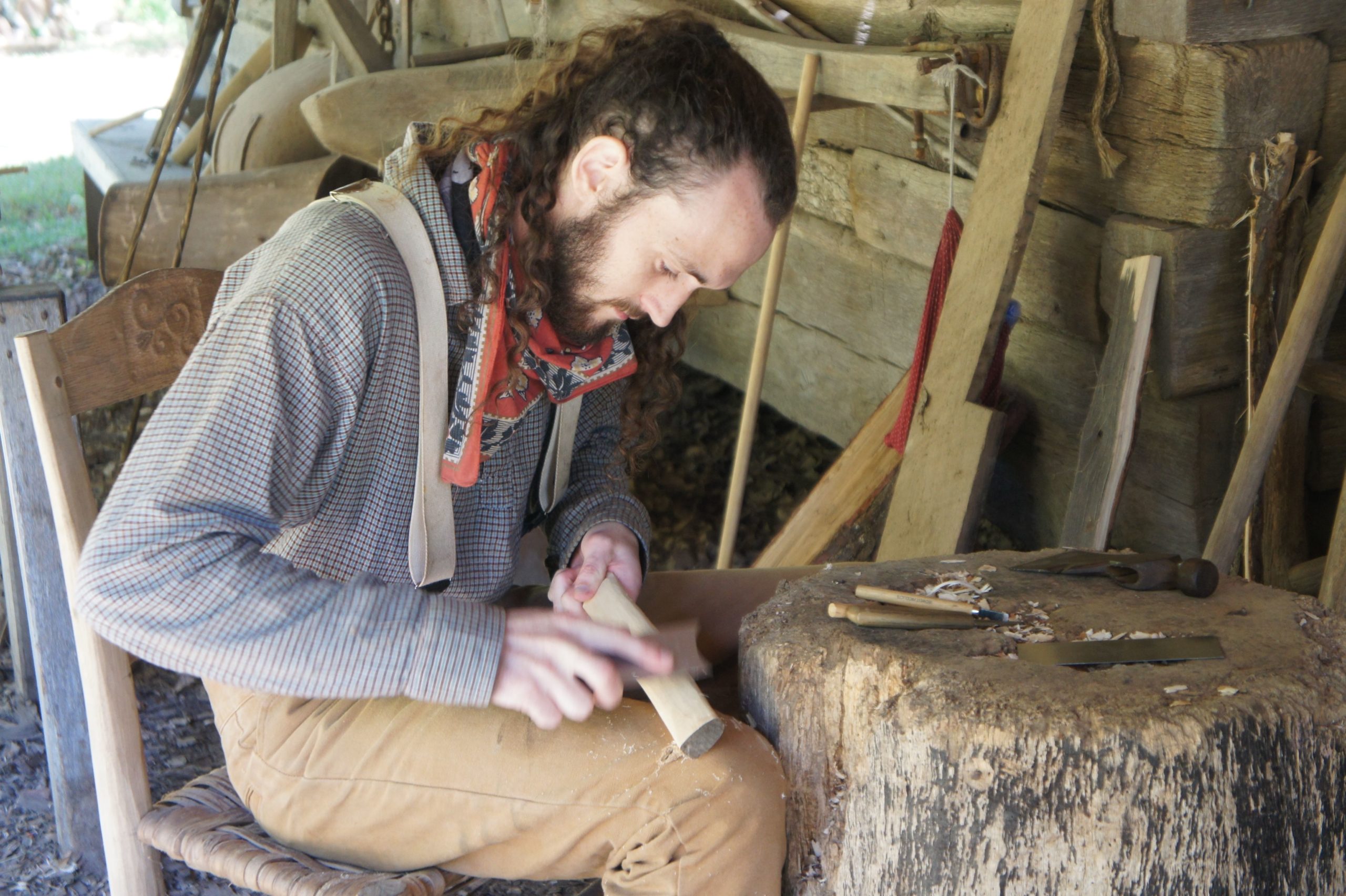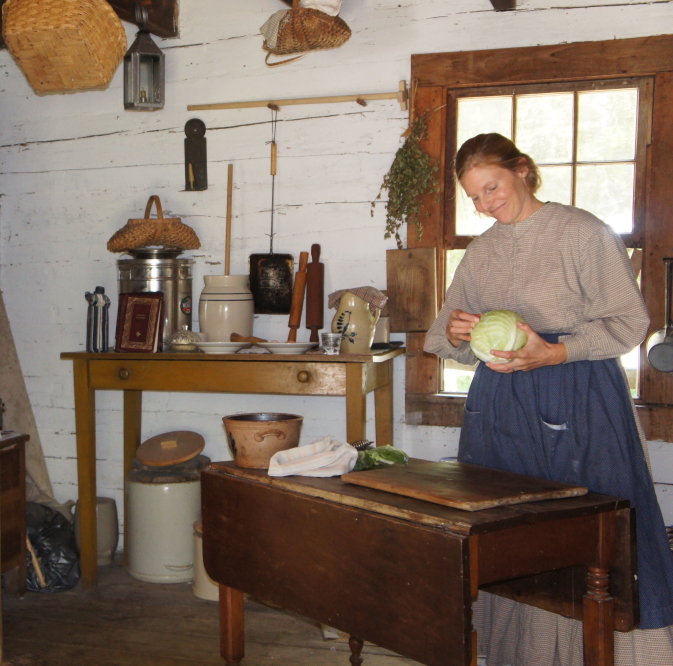Photos by Stell Simonton
On a recent fall day, a woman in a long checked dress sat on a porch spinning bright yellow wool into yarn. Chickens scratched in the yard nearby. Two mules stood impassively in the sun as a small group of children pointed at them excitedly. Inside the rustic house, another woman put a pan of beaten biscuits in a wood stove.
It’s a replica of an 1850s homestead at the Land Between the Lakes National Recreation Area, a 40-mile stretch of federal land between the Cumberland and Tennessee rivers on the Tennessee-Kentucky border managed by the U.S. Department of Agriculture Forest Service.

Lyn Hamper spins wool that came from sheep on the farm, as she explains the process to visitors. She gathered goldenrod blossoms to dye the wool.
Like many national parks and recreation areas, Land Between the Lakes offers history and science in an outdoor setting, with trained rangers and interpreters to present information to kids. It also has materials online as well as programming geared to state standards. Depending on the season, national and state parks can be of special interest to youth organizations in the pandemic, but the historic interpretation offered can be open to challenge.
“We’re appealing because we’re outdoors and it’s easy to social distance,” said Lyn Hamper, education director at the Homeplace 1850s Working Farm and Living History Museum, which is open March through October. Hamper is the spinner on the back porch of the double pen house that’s the centerpiece of the homestead, which has about 17 buildings including sheds, barns and a blacksmithy. As visitors walk by, she explains how she gathered goldenrod to dye her wool, which came from sheep raised on the homestead.
“We usually shear our sheep the first weekend of April each year,” she said.

Ethan Rhodes teaches visitors about tool-making as he fashions a wooden handle for a shingling axe at a working replica of an 1850s farm near Dover, Tennessee.
Inside the house, Melissa Gattrell, an interpreter at the site, explains how biscuits were made and food preserved in the 1800s. At the tool barn, Ethan Rhodes is shaving a wooden handle for a shingling axe. He explains the process and talks about the types of wood.
Children love the animals, Hamper said. A pair of Ayrshire oxen are pastured next to the blacksmith shop. The farm has several breeds of sheep that visitors can get close to. Dominique Chickens and Black Cayuga Ducks wander freely.
Gap in information about slavery
An interpretive center at the site entrance presents historical information, but notably fails to address slavery in the region and what that might have been like at an 1850s farm. The Homeplace 1850s Working Farm is described as a yeoman farm, which means it was worked by a farm family, presumably white. However, there is some African-American history in the area and some farms did have enslaved people, although there were not large plantations.
This gap in information is an omission at the homestead — one that would leave an African-American child wondering about their place in this history.
Some national and state parks are realizing that is missing information and taking steps to present a fuller picture, according to Candi Rawlins, executive director of the Tennessee Recreation and Parks Association. Parks are changing to include more information about slavery and are moving beyond a landowner perspective, she said.
Rawlins, who is on the steering committee of the Tennessee Afterschool Network, says parks are an important resource for out-of-school time organizations. She urges after-school leaders to contact their local parks to find the resources they offer and how to partner with them.

Melissa Gattrell is in front of a table used as a prep surface in the farm kitchen.
Interpretive services at Land Between the Lakes are provided by the nonprofit Friends of Land Between the Lakes. A program in February did explore some of the African-American communities in Lyon County, Kentucky, which is part of the area, said Carlin Fenn Lewis, a spokesperson for the USDA Forest Service at Land Between the Lakes.
In addition to the homestead, Land Between the Lakes has an environmental education center open year round. This center, called the Woodlands Nature Station, explains how animals are adapted to survive and explores conservation, among other topics. Visitors can see deer, coyotes, red wolves, a bald eagle and a bobcat, among other animals. Most were rescue animals that can’t be returned to the wild.
Visitors can also drive through a native grassland habitat where elk and bison can be seen. Land Between the Lakes encompasses one of the largest areas of undeveloped forest in the eastern United States.
The Golden Pond Planetarium and Observatory acquaints visitors with constellations and planets, explores space travel and gives a look at NASA’s Interstellar Boundary Explorer. It serves as a NASA Educator Resource Center.
A program guide explains the facilities and programs for groups at Land Between the Lakes.
The wealth of resources is a reminder of outdoor educational opportunities at national and state parks across the country. Many closed at the onset of the pandemic but may have reopened with social distancing and other safety guidelines.
It’s also a reminder that some historical narratives may be missing, leaving youth workers, educators and others needing to raise issues at these publicly owned spaces.










































